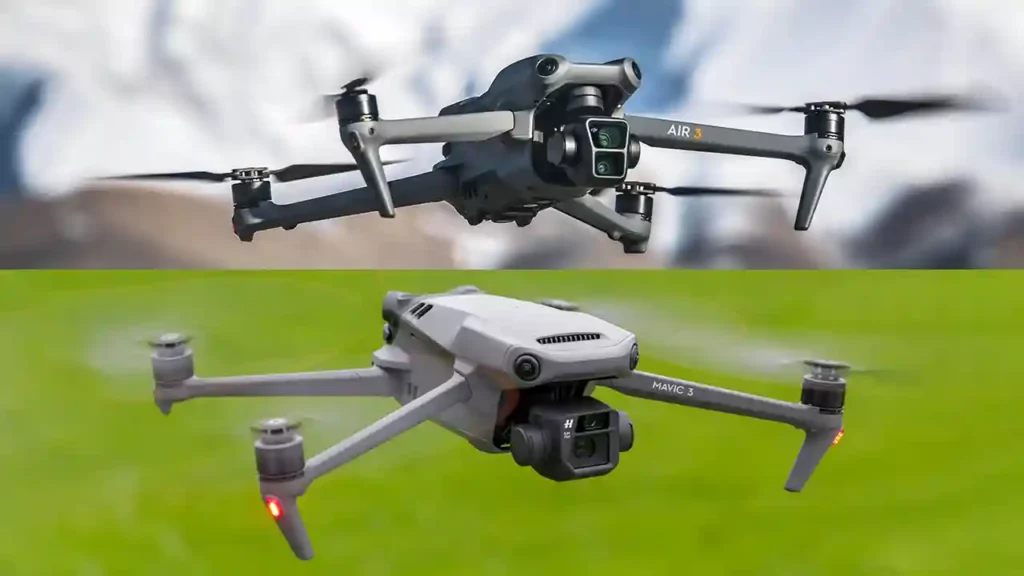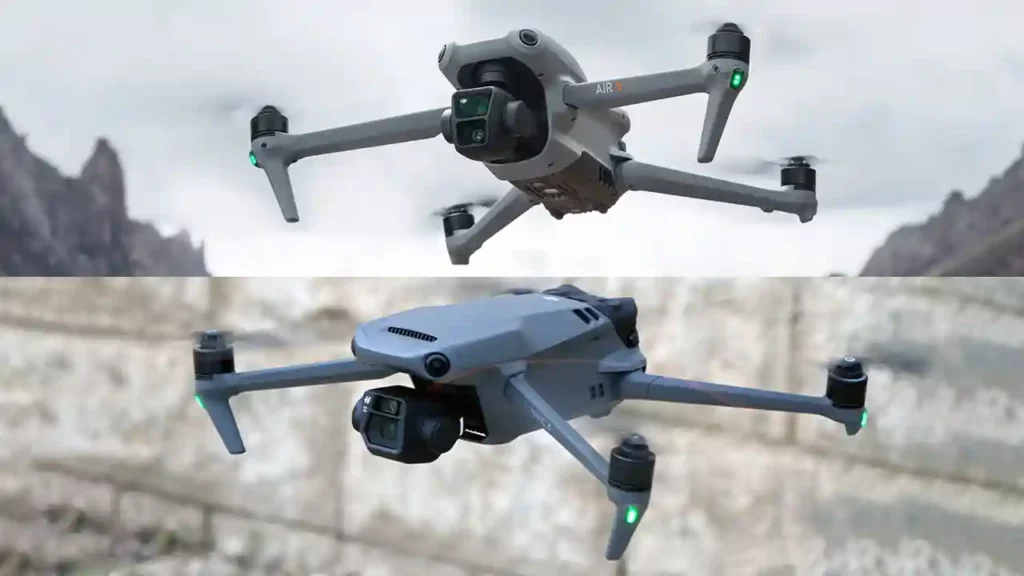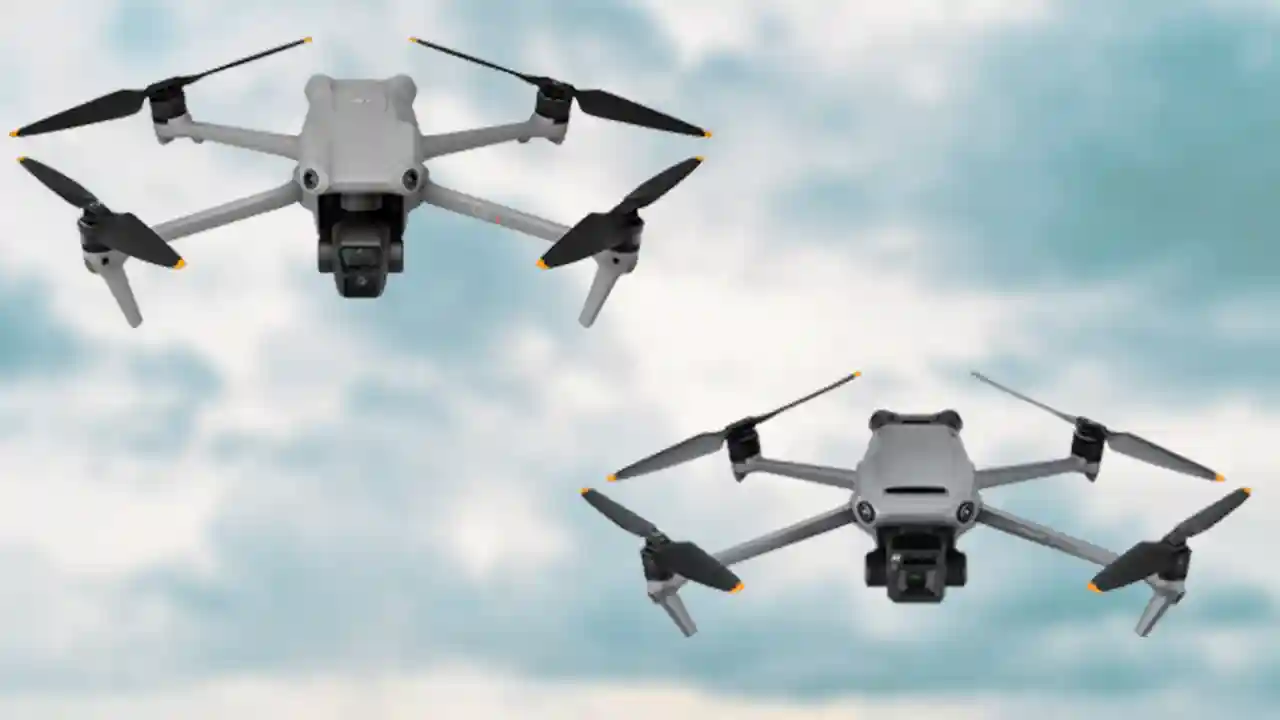Dronelost.com – Drones are amazing devices that can capture stunning aerial photos and videos, explore new places, and have fun. But with so many drones on the market, how do you choose the best one for your needs beetween DJI Air 3 vs Mavic 3?
DJI Air 3 and Mavic 3 are packed with advanced technology and capabilities that make them stand out from the crowd. They are used for various purposes, such as photography, videography, entertainment, education, and more.
But which one is better for you? We will compare the DJI Air 3 vs Mavic 3 in terms of design, camera, flight time, transmission, obstacle avoidance, flight modes, and price.
We will also give you our recommendation on which drone to buy based on your preferences and budget. By the end of this article, you will have a clear idea of which drone suits you best. Let’s get started!
DJI Air 3 and Mavic 3 Specs

The DJI Air 3 and the DJI Mavic 3 have impressive specs that make them powerful and reliable drones. They both have a top speed of 42.5 mph, a maximum altitude of 16404 ft, and a wind resistance of 23.6 mph.
They also have a 3-axis gimbal that stabilizes the camera and ensures smooth and stable footage. Here is a table that compares the specifications of the DJI Air 3 and the DJI Mavic 3
| Specification | DJI Air 3 | DJI Mavic 3 |
|---|---|---|
| Dimensions (folded) | 180 x 97 x 77 mm | 202 x 92 x 84 mm |
| Weight | 595 g | 900 g |
| Max speed | 42.5 mph | 42.5 mph |
| Max altitude | 16404 ft | 16404 ft |
| Wind resistance | 23.6 mph | 23.6 mph |
| Flight time | 46 minutes | 46 minutes |
| Video transmission system | OcuSync 4.0 | OcuSync 4.0 |
| Video transmission range | 12 miles | 12 miles |
| Obstacle sensing | Omnidirectional | Omnidirectional |
| Camera system | Dual | Tri |
| Wide-angle camera resolution | 12 MP | 20 MP |
| Wide-angle camera sensor size | 1/1.3 inch | 1 inch |
| Wide-angle camera aperture | f/1.7 | f/2.8 |
| Wide-angle camera zoom | 4x digital | 4x optical, 16x digital |
| Telephoto camera resolution | 12 MP | 12 MP |
| Telephoto camera sensor size | 1/1.3 inch | 1/2.3 inch |
| Telephoto camera aperture | f/2.8 | f/4.4 |
| Telephoto camera zoom | 7x hybrid | 28x hybrid |
| Micro camera resolution | N/A | 5 MP |
| Micro camera sensor size | N/A | 1/2.8 inch |
| Micro camera aperture | N/A | f/2.4 |
| Micro camera zoom | N/A | N/A |
| Video resolution | 4K | 5.4K |
| Video codec | H.264, H.265 | H.264, H.265, Apple ProRes (Cine version only) |
| Color science | DJI | Hasselblad |
| Gimbal | 3-axis | 3-axis |
| Remote controller | RC 2, RC-N2 | RC 2, Smart Controller (Cine version only) |
| Battery capacity | 3500 mAh | 5000 mAh |
DJI Air 3 vs Mavic 3

The DJI Air 3 and the DJI Mavic 3 are both foldable drones that are easy to carry and store. They have similar dimensions and weight, but the Air 3 is slightly smaller and lighter than the Mavic 3.
1. DJI Air 3 vs Mavic 3 Design
Both drones have a foldable structure that reduces their size when not in use. However, there are some differences in their dimensions and weight. The Air 3 measures 180 x 97 x 77 mm when folded and 183 x 253 x 77 mm when unfolded.
It weighs 595 g, which is slightly heavier than its predecessor, the Air 2S. The Mavic 3, on the other hand, measures 214 x 92 x 84 mm when folded and 282 x 253 x 84 mm when unfolded. It weighs 900 g, which is significantly heavier than the Air 3.
This means that the Air 3 is more portable and convenient to travel with than the Mavic 3. However, the Mavic 3 has a more robust and durable design that can withstand harsher weather conditions and environments. The Mavic 3 also has a better cooling system that prevents overheating and improves performance.
2. Camera
The camera is one of the most important aspects of a drone, as it determines the quality and versatility of the images and videos you can capture. Both the Air 3 and the Mavic 3 have impressive cameras that can deliver stunning results.
However, they have different camera systems that cater to different needs and preferences. The Air 3 has a dual-camera system that consists of a wide-angle camera and a medium tele camera.
The wide-angle camera has a 1/1.3-inch CMOS sensor, a 24 mm equivalent focal length, an f/1.7 aperture, and a 100-degree field of view. It can capture 12 MP stills and up to 4K video at 100 fps.
The medium tele camera has the same sensor size, a 70 mm equivalent focal length, an f/2.8 aperture, and a 34-degree field of view. It can capture 48 MP stills and up to 4K video at 60 fps.
The dual-camera system allows you to switch between different perspectives and zoom levels, creating a more dynamic and cinematic effect. The Air 3 also supports HDR, Hyperlapse, Panorama, and Timelapse modes, as well as various color profiles and formats.
The Mavic 3 has a tri-camera system that consists of a wide-angle camera, a telephoto camera, and a micro camera. The wide-angle camera has a 1/1.28-inch CMOS sensor, a 24 mm equivalent focal length, an f/2.8 aperture, and an 84-degree field of view. It can capture 20 MP stills and up to 5.1K video at 50 fps.
The telephoto camera has a 1/2.6-inch CMOS sensor, a 162 mm equivalent focal length, an f/4.4 aperture, and a 15-degree field of view. It can capture 12 MP stills and up to 4K video at 30 fps.
The micro camera has a 1/2.3-inch CMOS sensor, a 13 mm equivalent focal length, an f/2.8 aperture, and a 150-degree field of view. It can capture 12 MP stills and up to 2.7K video at 60 fps.
The tri-camera system allows you to switch between three different focal lengths and zoom levels, creating a more versatile and creative effect. The Mavic 3 also supports HDR, Hyperlapse, Panorama, and Timelapse modes, as well as various color profiles and formats. Additionally, the Mavic 3 Pro Cine version supports Apple ProRes video encoding, which is a professional standard for TV and video productions.
3. Flight Time
The flight time of a drone is another important factor to consider, as it determines how long you can fly and capture images and videos. Both the Air 3 and the Mavic 3 have impressive flight times that are among the best in the industry. However, there are some differences in their battery capacity and performance.
The Air 3 has a 3500 mAh battery that can provide up to 46 minutes of flight time. This is a significant improvement from the Air 2S, which had a 3500 mAh battery that could provide up to 31 minutes of flight time.
The Mavic 3 has a 5000 mAh battery that can provide up to 46 minutes of flight time. This is a slight improvement from the Mavic 2 Pro, which had a 3850 mAh battery that could provide up to 31 minutes of flight time.
However, the Mavic 3’s flight time may vary depending on the camera mode and settings. For example, the Mavic 3 Pro Cine version has a shorter flight time of 40 minutes when using the Apple ProRes mode.
4. Transmission
The transmission of a drone is another crucial factor to consider, as it determines the quality and stability of the video signal and the range and reliability of the remote control. Both the Air 3 and the Mavic 3 have advanced transmission systems that can deliver excellent performance and experience.
However, they have different transmission technologies and capabilities. The Air 3 uses the OcuSync 4.0 transmission system, which is the latest and most advanced version of DJI’s proprietary technology.
It can provide a video transmission range of up to 12 km (7.5 miles) and a remote control range of up to 15 km (9.3 miles). It can also support up to 1080p video resolution and up to 60 fps frame rate.
The OcuSync 4.0 transmission system can automatically switch between 2.4 GHz and 5.8 GHz frequencies to avoid interference and ensure a stable and clear signal. It can also support up to four devices simultaneously, including two remote controllers and two smart devices.
The Mavic 3 uses the Lightbridge 3 transmission system, which is a new and improved version of DJI’s original technology. It can provide a video transmission range of up to 15 km (9.3 miles) and a remote control range of up to 18 km (11.2 miles).
It can also support up to 1080p video resolution and up to 60 fps frame rate. The Lightbridge 3 transmission system can automatically switch between 2.4 GHz and 5.8 GHz frequencies to avoid interference and ensure a stable and clear signal. It can also support up to two devices simultaneously, including one remote controller and one smart device.
5. Obstacle Avoidance
The obstacle avoidance of a drone is another vital factor to consider, as it determines the safety and intelligence of the drone. Both the Air 3 and the Mavic 3 have omnidirectional obstacle avoidance systems that can detect and avoid obstacles in all directions. However, they have different obstacle avoidance sensors and capabilities. The Air
3 has six obstacle avoidance sensors that cover the front, back, left, right, top, and bottom of the drone. It can detect obstacles up to 40 m (131 ft) away and avoid them up to 15 m (49 ft) away.
It also has a binocular vision system that can sense the terrain and adjust the altitude accordingly. The Air 3’s obstacle avoidance system can work in normal, sport, and tripod modes, as well as in some intelligent flight modes.
The Mavic 3 has 10 obstacle avoidance sensors that cover the front, back, left, right, top, bottom, and corners of the drone. It can detect obstacles up to 64 m (210 ft) away and avoid them up to 30 m (98 ft) away.
It also has a binocular vision system that can sense the terrain and adjust the altitude accordingly. The Mavic 3’s obstacle avoidance system can work in normal, sport, and tripod modes, as well as in all intelligent flight modes. Additionally, the Mavic 3 has an advanced APAS 5.0 system that can plan the best path to avoid obstacles and fly smoothly.
6. Flight Modes
The flight modes of a drone are another essential factor to consider, as they determine the functionality and fun of the drone. Both the Air 3 and the Mavic 3 have various flight modes that can enhance your flying and shooting experience. However, they have different flight modes and capabilities.
The Air 3 has the following flight modes:
- Normal: This is the default mode that allows you to fly and control the drone manually.
- Sport: This mode increases the speed and agility of the drone, allowing you to fly faster and more dynamically.
- Tripod: This mode reduces the speed and sensitivity of the drone, allowing you to fly more steadily and precisely.
- MasterShots: This mode allows you to select a subject and let the drone automatically capture a series of cinematic shots with different angles and movements.
- FocusTrack: This mode allows you to track and follow a subject with three sub-modes: ActiveTrack 5.0, Spotlight 2.0, and Point of Interest 4.0.
- QuickShots: This mode allows you to capture short and creative videos with predefined movements and effects, such as Dronie, Rocket, Circle, Helix, Boomerang, and Asteroid.
- Hyperlapse: This mode allows you to create stunning timelapse videos with four sub-modes: Free, Circle, Course Lock, and Waypoint.
The Mavic 3 has the following flight modes:
- Normal: This is the default mode that allows you to fly and control the drone manually.
- Sport: This mode increases the speed and agility of the drone, allowing you to fly faster and more dynamically.
- Tripod: This mode reduces the speed and sensitivity of the drone, allowing you to fly more steadily and precisely.
- MasterShots: This mode allows you to select a subject and let the drone automatically capture a series of cinematic shots with different angles and movements.
- FocusTrack: This mode allows you to track and follow a subject with three sub-modes: ActiveTrack 5.0, Spotlight 2.0, and Point of Interest 4.0.
- QuickShots: This mode allows you to capture short and creative videos with predefined movements and effects, such as Dronie, Rocket, Circle, Helix, Boomerang, and Asteroid.
- Hyperlapse: This mode allows you to create stunning timelapse videos with four sub-modes: Free, Circle, Course Lock, and Waypoint.
- Panorama: This mode allows you to capture panoramic photos with four sub-modes: Sphere, 180°, Wide-Angle, and Vertical.
- Timelapse: This mode allows you to capture timelapse photos with four sub-modes: Motionlapse, Tracklapse, Nightlapse, and Holy Grail.
- SmartPhoto: This mode allows you to capture photos with intelligent scene recognition and optimization, such as HDR, Hyperlight, and Scene Recognition.
7. DJI Air 3 vs Mavic 3 Price
The price of a drone is another important factor to consider, as it determines the value and affordability of the drone. Both the Air 3 and the Mavic 3 have different prices and packages that offer different options and accessories.
The Air 3 has two packages: the standard package and the Fly More Combo. The standard package includes the drone, one battery, one remote controller, one pair of propellers, one gimbal protector, one RC cable, one USB-C cable, one power adapter, one power cable, and one storage bag.
The Fly More Combo includes everything in the standard package, plus two extra batteries, one battery charging hub, one ND filter set, one battery to power bank adapter, one shoulder bag, and three pairs of propellers. The standard package costs $999, while the Fly More Combo costs $1299.
The Mavic 3 has three packages: the standard package, the Fly More Combo, and the Pro Cine. The standard package includes the drone, one battery, one remote controller, one pair of propellers, one gimbal protector, one RC cable, one USB-C cable, one power adapter, one power cable, and one storage bag.
The Fly More Combo includes everything in the standard package, plus two extra batteries, one battery charging hub, one ND filter set, one battery to power bank adapter, one shoulder bag, and three pairs of propellers.
The Pro Cine includes everything in the Fly More Combo, plus a 1 TB SSD, a DJI Smart Controller, and a ProRes license. The standard package costs $2199, while the Fly More Combo costs $2699, and the Pro Cine costs $4999.
The DJI Air 3 and the Mavic 3 are both amazing drones that offer great performance, features, and value. However, they have different strengths and weaknesses that make them suitable for different users and scenarios.
The Air 3 is more portable and affordable, while the Mavic 3 is more powerful and versatile. The Air 3 is ideal for beginners and hobbyists who want a simple and fun drone that can capture high-quality photos and videos.
The Mavic 3 is ideal for professionals and enthusiasts who want a sophisticated and advanced drone that can capture stunning photos and videos. Ultimately, the choice depends on your personal preferences and budget.
